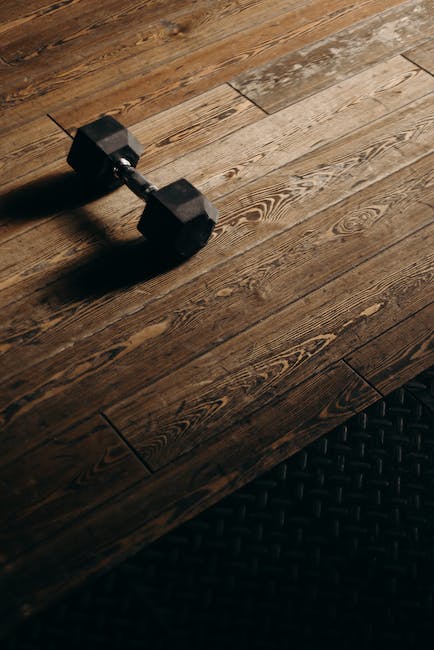Hear ye, hear ye, all ye gym rats and fitness enthusiasts! Strap on your wrist wraps and chalk up your hands, because we’re about to delve into the fascinating world of weight lifting elbow mechanics. Now, I know what you’re thinking: “But wait, isn’t it just bending your arm and lifting heavy things?” Oh dear, sweet novice gym-goer, if only it were that simple. Brace yourselves for a journey into the intricate workings of the elbow joint, where we’ll uncover the secrets of preventing injury and maximizing your gains. Let’s get flexin’.
Contents
- 1 1. The Anatomy of the Elbow Joint and Its Role in Weightlifting
- 2 2. Common Elbow Injuries and Their Impact on Weightlifting Progress
- 3 3. Proper Form and Technique to Prevent Elbow Strain and Injury
- 4 4. Rehabilitation and Recovery Strategies for Elbow Injuries from Weightlifting
- 5 Rehabilitation and Recovery Strategies for Elbow Injuries from Weightlifting
- 6 5. Customizing Your Lifting Plan to Safely Challenge Your Elbow Joint
- 7 Customizing Your Lifting Plan to Safely Challenge Your Elbow Joint
- 8 Don’t be Elbowed Out of the Gym…
1. The Anatomy of the Elbow Joint and Its Role in Weightlifting
The Elbow Joint – Your Ticket to Lifting Heavy Stuff
Got a case of noodle arms? Fear not, my friends! Your solution lies in the humble elbow joint – the unsung hero of weightlifting.
Essentially a hinge joint, the elbow connects the upper arm bone (humorous, anyone?) to the two bones in the lower arm (ulna and radius, if you’re feeling technical). But don’t let its simple design fool you! The elbow joint is responsible for flexing and extending your arm, as well as rotating your forearm.
- Pro tip #1: To avoid unwanted injuries, ensure your elbow tracks along your torso as you lift weights. A flared elbow is a surefire way to hurt yourself and ruin your lifting game.
- Pro tip #2: Want to work those triceps? Keep your elbows tight against your body as you do push-ups and other tricep-focused exercises. You’ll be feeling the burn in no time – trust me!
So now you know: your elbow joint is key to improving your weightlifting prowess. Treat it well, keep it strong, and show those weights who’s boss!

2. Common Elbow Injuries and Their Impact on Weightlifting Progress
Elbow injuries are no joke, especially when you’re trying to lift heavy weights. Here are three common elbow injuries you may encounter as a weightlifter:
- Golfer’s Elbow: A condition in which the inner tendons of the elbow become inflamed due to overuse. It’s called “Golfer’s Elbow” because it’s common in golfers, but let’s be honest, the only thing we’re swinging is a barbell. Symptoms include pain and tenderness on the inside of the elbow, which can make it difficult to grip weights or lift.
- Tennis Elbow: The opposite of Golfer’s Elbow, Tennis Elbow affects the outer tendons of the elbow. It’s caused by repetitive motions, such as lifting weights or playing tennis (hence the name). Symptoms include pain and tenderness on the outside of the elbow, which can make it difficult to hold weights or perform certain exercises.
- Biceps Tendinitis: A condition in which the tendon that attaches the biceps muscle to the elbow becomes inflamed. This can result in pain and weakness when lifting weights or performing certain exercises.
So, what can you do to avoid these injuries and keep making gains? Here are a few tips:
- Warm up properly: Take the time to warm up your elbows before diving into your workout. Try some light cardio or arm circles to get the blood flowing.
- Use proper form: Improper form can put extra strain on your elbows, making them more susceptible to injury. Make sure you’re using proper form for each exercise.
- Listen to your body: If you feel pain or discomfort in your elbows, take a break. Continuing to lift through the pain will only make the injury worse and hinder your progress in the long run.
- Biceps curls and triceps extensions should be done in low weights and high repetitions(15-20)
3. Proper Form and Technique to Prevent Elbow Strain and Injury
First things first, let’s talk form. If you’re lifting weights with your elbows in improper alignment, you’re just asking for elbow strain. Trust us, your elbows don’t want to be in awkward, contorted positions any more than your body wants you to be watching Keeping Up With The Kardashians. Make sure your elbows are at a natural angle, and keep them strong and steady throughout your entire lift.
Next up, technique. If you’re gripping your weights too tightly, you’re cheating yourself out of a proper workout and you’re setting yourself up for a one-way ticket to Elbow Strain City. Relax your grip, and allow your muscles to do the work. This way, you’ll get the full benefit of your workout, and your elbows will thank you for it.
Pro tip: Don’t forget about stretching! Stretching helps to warm up your muscles and prevent injury. Plus, it’s a great way to show off your yoga moves to everyone at the gym. Remember to take breaks and stretch in between sets, and your elbows will thank you for it. Trust us, they’ll be the happiest joints in the gym.
4. Rehabilitation and Recovery Strategies for Elbow Injuries from Weightlifting
Rehabilitation and Recovery Strategies for Elbow Injuries from Weightlifting
Okay, so you’ve overdone it with the bicep curls and now your elbows feel like they’re going to snap in half. Don’t panic, we’ve got some strategies to help you recover:
- Ice it up: This may seem like common sense, but some people still don’t believe in the power of icing. Apply ice to your elbows for 15-20 minutes every hour for the first 48 hours after the injury and see the swelling go down.
- Stretch it out: Elbow injuries can be caused by tight muscles and tendons. Stretching your forearms and triceps can help alleviate some of the pain. Try these stretches: grip a towel and pull it towards you behind your back, or hold your elbow with your opposite hand and gently pull it downwards.
- Take a break: As much as you want to pump iron, it’s important to give your elbows a break. Resting your arms for a few days can help reduce inflammation and prevent further damage.
There’s more to recovery than just taking it easy, though. Here are some exercises you can do to help strengthen your arms:
- Bicep curls: Wait, what?! Didn’t we just say to take a break? Yes, we did. But once the pain and inflammation have subsided, bicep curls can be a great way to start strengthening your arms again.
- Wrist curls: Sit on a bench with a weight in one hand, palm facing upwards. Lower the weight slowly and then bring it up again using only your wrist. Repeat.
- Reverse curls: Similar to wrist curls, this exercise works the muscles on the underbelly of your forearm. Hold a weight in one hand with your palm facing down and lift it towards your shoulder. Repeat.
5. Customizing Your Lifting Plan to Safely Challenge Your Elbow Joint
Customizing Your Lifting Plan to Safely Challenge Your Elbow Joint
1. Start with a proper warm-up: Whether you’re training for the Olympics or just trying to impress your crush at the gym, warming up is essential for preventing injury. Make sure to get your blood flowing and your joints lubricated before hitting the weights. Try some light cardio, dynamic stretching, or mobility exercises to get your elbow joint primed for action.
2. Mix up your exercises: Doing the same exercises over and over again can lead to overuse injuries and muscle imbalances. To keep your elbow joint safe and healthy, switch up your exercises regularly. Try different variations of your favorite movements or incorporate new exercises altogether. Not only will this prevent injury, but it’ll also keep your workouts fresh and interesting.
3. Use proper form: Okay, I know this one sounds obvious, but you’d be surprised at how many people neglect proper form in the pursuit of gains. Lifting with improper form places unnecessary stress on your elbow joint and can lead to chronic pain or injury. Always prioritize form over weight and make sure to use proper technique for each exercise you perform. If you’re not sure how to perform a certain movement correctly, don’t be afraid to ask a trainer or fitness professional for help. Your elbow joint will thank you.
Don’t be Elbowed Out of the Gym…
Now that you understand the mechanics of weight lifting elbow (and wow, aren’t you just the smart cookie?), it’s time to hit the gym and show off those gains. But remember: safety first! Take care of your elbows and don’t go elbowing your gym friends in the face while trying to show off your form.
With a little bit of knowledge and a whole lot of hard work, you can become the resident gym elbow expert. So go forth and lift (with your elbows in mind), my friends!








Leave A Comment